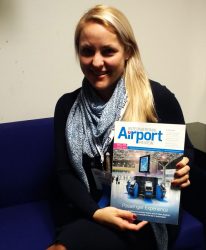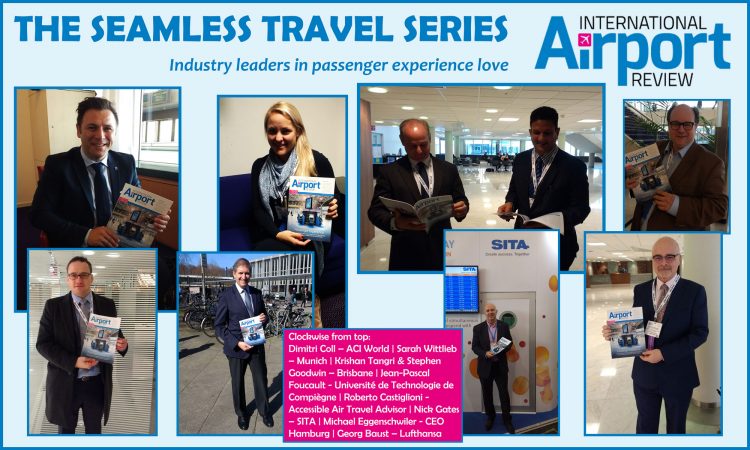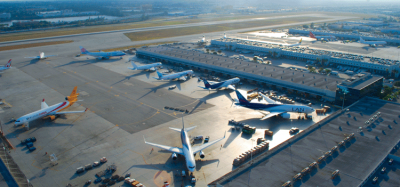Rethinking an airport’s relationship with technology | The Seamless Travel Series
- Like
- Digg
- Del
- Tumblr
- VKontakte
- Buffer
- Love This
- Odnoklassniki
- Meneame
- Blogger
- Amazon
- Yahoo Mail
- Gmail
- AOL
- Newsvine
- HackerNews
- Evernote
- MySpace
- Mail.ru
- Viadeo
- Line
- Comments
- Yummly
- SMS
- Viber
- Telegram
- Subscribe
- Skype
- Facebook Messenger
- Kakao
- LiveJournal
- Yammer
- Edgar
- Fintel
- Mix
- Instapaper
- Copy Link
Posted: 19 April 2017 | Sarah Wills | Editorial Assistant, Sarah Wittlieb | Head of Innovation | Munich Airport | No comments yet
How is technology reshaping the way in which airports interact with their passengers and vice versa?


In an interview for International Airport Review, Sarah Wittlieb, Head of Innovation at Munich Airport, and speaker at Passenger Terminal Expo 2017, speaks to our Digital Editor, Roy Manuell about the ways in which technology aids, and also creates challenges, for modern day passenger experience.
Your speech here at Passenger Terminal Expo focused on ‘megatrends’. Could you provide our readers with an introduction to this topic?
It shouldn’t be a surprise to the aviation industry that it’s very important, crucial even, to deal with megatrends, especially as technology and customer needs evolve. Megatrends, while slow evolving, can influence aspects and processes within our lives, and the perceptions held by government and society, perhaps even for decades. To give fairly recent examples, many people have bought Apple watches or begun car sharing when making journeys. What I am going to present is how an airport can use those megatrends to identify what the main issues for the coming years will be and what an airport could do in order to be prepared for them.
I think that, typically, the new technological innovations that our passengers use don’t usually come from the aviation industry; they come from companies like Google, like Facebook, and also from the automotive sector, from mobility companies. However, we still need to identify what is likely to happen and how we could be prepared for that, in order to save the business model or create a new one.
So this is essentially a question of how your airport can adapt to the rapidly changing world of technology?
Yes, technologies, and also for changing customer needs. If you told everyone 15 years ago that today they would have an iPhone or smartphone they wouldn’t have believed you! You have to think about what is happening in the market and not only in the aviation industry, and also about what we, as an airport, do.
The megatrends – and also the microtrends – that we are looking for, are not only concerning aviation. We look at what is happening in different sectors all around the world. We are constantly scouting for likely or emerging trends.
Could you give a specific example of how one of these technologies is, or will, adopt itself towards that kind of technology?
I will give two examples; I guess many people are familiar with Google Street View. There are so many people who, before they book a vacation or trip, will go online and look how at where the hotels are and how they could get from A to B. They will see what’s around, where the nearest restaurants are, and get a feel for how the place looks and feels.
We know from research with our own customers that there are many people who would like to know more information about the terminals, before they arrive at the airport. Even, simply, how do I get from parking to the terminals?
So, in light of this, we are working with a start-up company, called Navvis. They developed a type of a camera wagon system which created 360 degree views of our airport. Our passengers can view this on our website homepage, on our app, or within different channels. The system benefits not only people who would like to prepare their route before beginning their journey, but also those who are already inside in the airport. Passengers can see how to get from A to B, which kind of restaurants you have, the retail and shopping facilities you offer, and we feel that it’s a very good reaction to finding an answer to this question.
Nonetheless, you always have to look at the security of the data, and that is why I’m so pleased we chose to work with a start-up company.
Another example is a project which is due to be online in two months’ time, called ‘Mobility as a Service’. We know that many of our passengers, many of whom are not originally from Munich, arrive at Munich Airport wanting to know how they will get from the airport to their final destination. Developed in cooperation with Siemens Mobility, ‘Mobility as a Service’ is an online service, whereby people get real-time information, showing the possible routes and means they have to get from A to B. It is not only for those who have used their own car and parked at the airport, it also provides information about trains, car sharing, taxis etc.
‘Mobility as a Service’ doesn’t just provide the same information that you can get already through other mediums. We have information that some others don’t; We know how long people have to wait to get through security checks, or how long they have to wait to collect their luggage, and this real-time information is included in our service.
It’s real-time information which means that if there’s a problem with, for instance, their intended train journey, passengers can directly see what they could do instead, and also ticketing as well.
That’s very exciting. Going back to the issues you mentioned regarding big data, and holding data, firstly what are the precise dangers?
We always strive to see things from the perspective of the customer. This is always at the forefront of our minds in any issue. And our customers, especially in Germany, generally dislike showing their data like they do, for example, in the US. So, naturally, we have to deal with this aspect, while always being mindful of what is and isn’t allowed. A large company who is, for example, known for selling that data to different companies, would not be of interest for us to work with, for that very reason. Yes we are an airport, but it’s no longer only a question of infrastructure.
In Europe especially security is at the forefront of people’s minds at the moment, how might this affect passenger experience? How do airports ensure a very high level of security without compromising passenger experience?
In my opinion, you always have to look at a passenger’s journey as a whole, not just at particular points. There may be some touchpoints where safety and security need to take priority, but I think that most passengers would appreciate this, and therefore not be expecting to get the best entertainment in that situation. I think that most of us are very happy if we experience a secure airport in which we feel comfortable. You should never only think about when the customer is at one place or point in the airport because for us it’s the question of the whole journey from when the customer starts to plan their trip or vacation to when they arrive home again.
Generally speaking, which new technologies in the aviation industry are you most excited about?
First of all, new mobility or connective mobility. I think it’s no longer a question of which kind of mobility provider will be the one who sells the product, for example, a car. I think in the future passengers will expect to only buy one ticket for their whole journey, across different transport modes, where first, for example, they take a car share to the airport, then fly to a different destination, arrive get out and take a train, or a bus, or a taxi. I don’t believe passengers will be willing to buy separate tickets for their transport. I think it should be one ticket and that means cooperation, so new mobility is very, very important for the future.
Another would be the best combination of online to offline, because I don’t think that online alone is the best solution. There are still moments when people love to see each other.
Of course not everybody is online, though the majority of us are. How do we connect with those who are not online, who don’t have a smartphone or internet devices?
Actually, I don’t think it’s a key question for airports, or for mobility, because research from speaking to our passengers has shown that on average every person has more than one smart device with them during their journey, for example a smartphone and/or a tablet.
What about the elderly passenger, who doesn’t have a tablet or a smartphone at all?
We did a workshop with what we call the ‘Silver Generation’. For us, the results were really surprising because whilst we had assumed that the majority of them didn’t use or have an iPhone or a tablet or device, most of them said that they do own one, but just that they weren’t willing to use it for all processes. So I guess it would still be a question of a good combination; You will always have some people to help those who need it at the airport. And it’s not just a question of age either, there will also be people with special needs, lost baggage, or incidences where our passengers will still prefer to talk to a person.
If you had to name the biggest threat to passenger experience, what would you say that is?
The biggest threat might be that people who are always online are not able to fully experience the situation where they are at that moment. If you look at the way people move, and it is not just in airports, even when people walk through cities for example, with a smartphone in their hand, they’re walking around and they’re not really feeling or engaging with what is happening around them. It’s a real challenge to catch them, and which channels to use.
Our own digital unit are really successfully looking at how we can reach these passengers at particular touchpoints, but it is a huge challenge. For example, if you look at passengers who are standing in the duty free shop, they can open their smartphones and look up the prices for the same products if they were to buy them online.
Imagine we’re having this conversation in one years’ time, what will have changed?
Actually, it is possible that there could be a main change in how an airport is used. At Munich Airport we carry out a lot of testing of new prototype products with like-minded companies who realise it is a question of cooperating and co-creating. Together with those companies as a partner, we develop new products which we test at the airport. Munich Airport creates a great test environment because there are so many people here every day who are interested in trying something new and seeing a product they have never seen before.
What sets Munich apart from other European Airports?
For me, Munich Airport is a perfect combination, it’s a really unique place because if you arrive at Munich Airport you instantly recognise where you are. You could not mistake us for any airport anywhere in the world, because we have the perfect combination of premium, 5 star luxury products, and the really good services that we offer, but in combination with what we call the ‘Gemütlichkeit’, people coming together and having fun together, and that’s very unique. We have many people who go to the airport just to experience that, just to go at the weekend, to do some shopping, see the people who are travelling from all around the world, sit together and share a conversation with them. For us, it is more than just an airport.
The Seamless Travel Series so far
The conversation is shifting. It is no longer a question of passenger experience. Air travel is now defined by ensuring seamless travel. In this new online series, International Airport Review will explore different perspectives from industry leaders such as SITA, Munich Airport, ACI World and many more to consider the ways in which the concept of seamless travel is now defining the changing world of air travel.
For an introductory definition of ‘seamless travel’, click here…


Elevating experience at Hamburg – Hamburg CEO Michael Eggenschwiler
Small changes, big differences for PRMs – Roberto Castiglioni, Accessible Air Travel Advisor
Related topics
Aeronautical revenue, Economy, Information technology (IT), New technologies, Wi-Fi


















